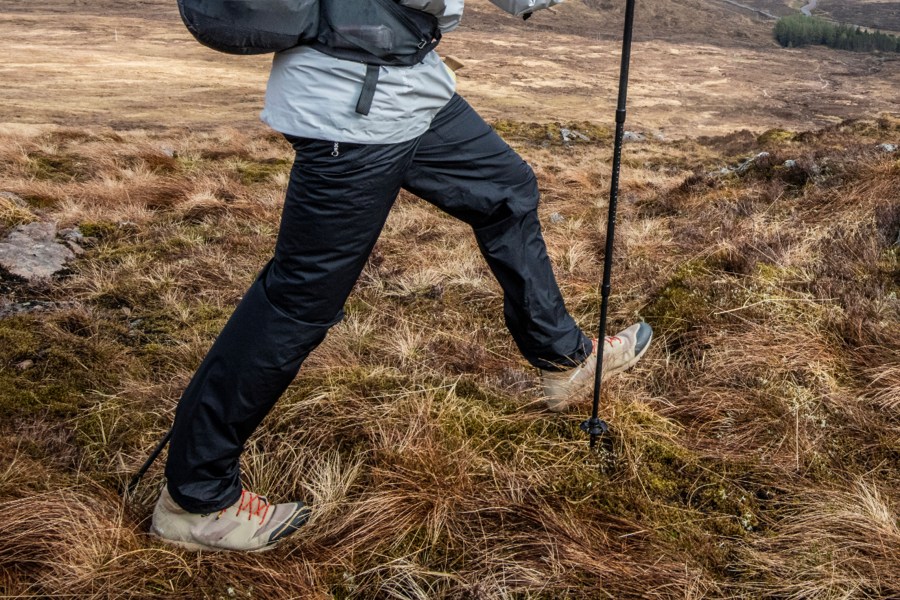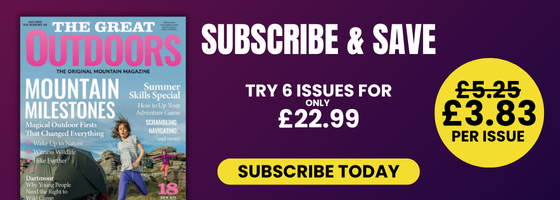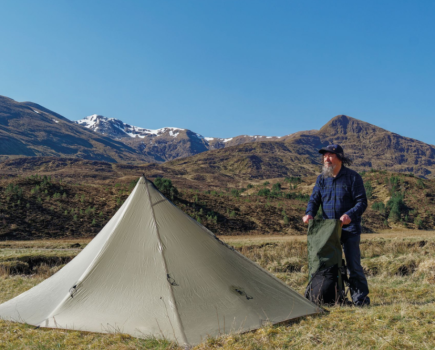Not so long ago, it was taken as gospel that every hiker needed a big pair of solid, chunky hiking boot to help them stomp over any terrain. Things have changed a little in recent years, however, with some people starting to move towards a lighter, nimbler approach to footwear and choosing hiking shoes, walking shoes or trail running shoes instead.
While a pair of hiking boots can come in at as much as a 35 ounces or a kilogram in weight, hiking shoes can come in as light as 14 ounces or 400g. Over the course of a day, especially if you’re carrying a heavy backpacking pack or covering a big distance with ascent thrown in too, that weight saving can make a real difference to your energy levels.
These days, it’s possible to find hiking shoes that will offer many of the benefits that hiking boots bring too. Many options have just as much grip, waterproofing and protection. But the trade-off to consider, however, is that hiking shoes don’t provide as much ankle support as some hiking boots and that support can be important if you’re hiking with a heavy backpack. The same goes for if you’re hiking over very uneven or boggy terrain.
If you’re wondering whether you should buy hiking boots or hiking shoes, you should make a decision based on your own requirements and the types of trips you’ll be needing the footwear for. If you’re taking on some rocky alpine climbs, for instance, then you might be better off with some footwear that’ll provide some ankle support, whereas if you’re heading off into a hot area to take on some well-defined trails, you’ll more than likely benefit from something low cut and light that’ll let your feet breathe.
Most hikers will have a pair of hiking boots and a pair of hiking shoes and will wear the pair that suits hike they’re taking on. When I hiked the Cambrian Way a few years ago, for example, I decided to wear a pair of Danner boots as I knew that I’d be facing bogs, boulders and scree slopes but when I walked the Camino de Santiago through Spain during a hot summer, I wore a breathable pair of trail shoes.
Why you can trust The Great Outdoors
The Great Outdoors is Britain’s original mountain magazine. We have been helping people to explore from sea to summit, valley to mountain top for more than 40 years. We’re here to help you make the most of your time outside. With over 200 years’ experience between them, our gear testing team is the most experienced in Britain, including mountain leaders and instructors, wildlife photographers and rangers, scramblers, hikers, bikers, boaters and runners. Our gear reviews are renowned for their rigour, trustworthiness and independence. Find out more about how we test.
Best hiking shoes: our pick
- Keen NXIS EVO Waterproof – Best hiking shoe for women
- La Sportiva TX5 Low GTX – Best hiking shoe for men
- Berghaus Ground Attack Active GTX – Best lightweight hiking shoe
- Salomon X Ultra 4 GTX – Best for everyday use
In this article you’ll find our selection of the best hiking shoes we’ve tested and how we got on with them. There’s a mix of footwear types, from trail running shoes that are great for hiking in to specialist shoes designed specifically for hiking. We’ve also added some budget hiking shoes into the mix here.
Best in Category
Keen NXIS EVO Waterproof
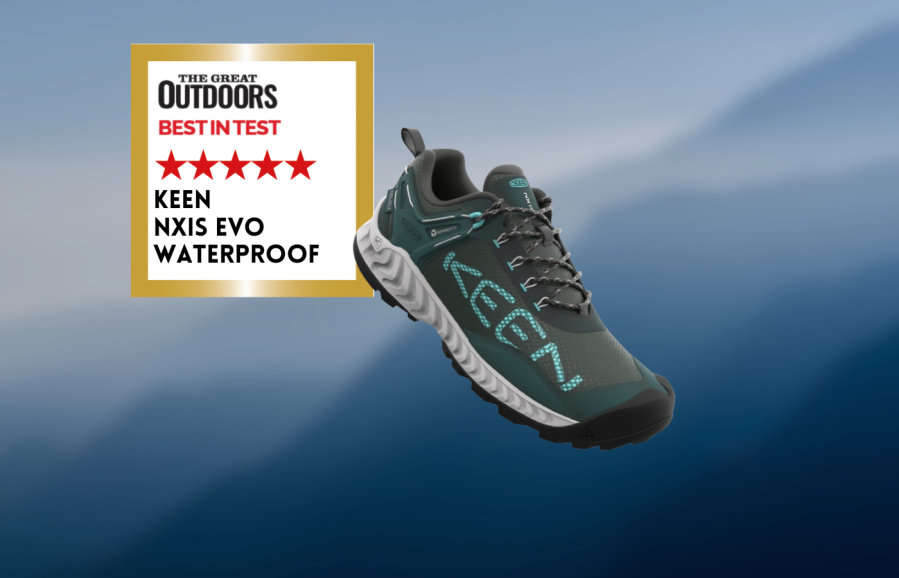
Lara Dunn’s Best in Test
Thankfully, the price reflects this and given how versatile a shoe this is – it looks good and goes great with jeans- they actually demonstrate excellent value for money.- Flexible trainer-like feel and fit
- Lightweight
- Comfy
- Not as durable as some
| Quick specs | |
|---|---|
| Price: £135 Weight: 642g (for size 39) Materials: Mesh and textile upper, KEEN.DRY waterproof membrane, KEEN.ALL-TERRAIN rubber outsole Features: KonnectFit heel-lock lacing, reinforced high wear areas, 4mm multi-directional outsole lugs Sizes: UK4-UK9 / EU37-43 (including half sizes) Women’s/Men’s Version: Women’s (men’s direct equivalent available) www.keenfootwear.com |
The Keen NXIS EVO Waterproof is a lightweight hiking shoe designed for fast-paced hikers and those who prefer a lighter shoe. It offers traction, protection, and support, making it suitable for those with good joints and fit. The shoe’s comfortable fit and agile trail experience make it a go-to choice for those with a daypack or no pack. The outsole lugs are deep and well-shaped, providing good traction on various surfaces and conditions. The PFC-free treatment of the mesh fabric uppers and waterproof membrane ensure feet stay dry without overheating. The shoe can be used all year round, with reinforced fabric uppers and a rubber toe bumper. The shoe ages quicker than average hiking shoes, but its versatility and excellent value for money make it a worthwhile investment.
Read Lara Dunn’s full Keen NXIS EVO Waterproof Review
Best in Category
La Sportiva TX5 Low GTX

Alex Roddie’s Best in Test
Overall I found this shoe great for a wide variety of mountain applications – with a slight bias towards steep and rocky stuff.- Excellent sole
- Precise Lacing
- Durable Uppers
- Great for scrambling
- A little stiff for longer hikes
- Heavier than other options
| Quick specs | |
|---|---|
| Price: £179.99 Weight: 500g (UK 11) Materials: nubuck uppers, rubber rand and toecap Features: abrasion resistant, stabilizing footbed and insole in shock-absorbing injected EVA, Mythos-Style lacing system, Vibram Megagrip outsole Waterproof: Gore-Tex Sizes: men: EU 37-47.5, UK 4.5-13.5; women: EU 36-42, UK 3.5-9.5 lasportiva.com |
The La Sportiva TX5 Low’s hiking shoes are lightweight and stiff, thanks to their nubuck uppers. They are waterproof but not breathable, making them feel stuffy in hot weather. The solid sole unit provides boot-like stability, with deep, wide-spaced lugs that grip on various surfaces. The shoe’s high, stiff rubber rand protects the uppers. The La Sportiva TX5 Low’s have a snug fit, but the stiffness may be an acquired taste for long hikes. The lacing system is complex but offers a precise fit. While great for various mountain applications, they may not be suitable for fast-paced or long-distance adventures due to their weight and stiffness.
Read Alex Roddie’s full La Sportiva TX5 Low GTX Review
Salewa W’s MTN Trainer 2 GTX
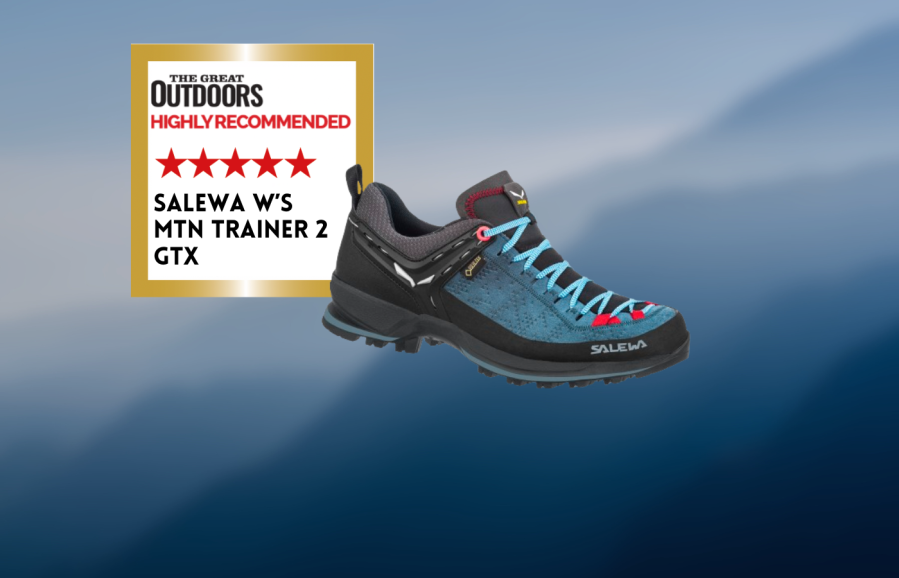
Lara Dunn Highly Recommends
If you’re looking for something to keep you comfortable and safe on alpine hikes, scrambles and via ferratas, they are well worth the investment and should last for years.- Supportive
- Rugged
- Highly Technical
- Heavy
- Expensive
| Quick specs | |
|---|---|
| Price: £200 Weight: 1004g (for size 41) Materials: Suede leather uppers, Vibram Mountain Trainer Evo outsole, Gore-Tex lined Features: Female specific. last, protective rand, climbing shoe style lacing with 3F heel cables, Ferrata Zone on outsole. Sizes: UK3-UK9 (including half sizes)/EU36-43 Women’s/Men’s Version: Women’s (men’s direct equivalent available) www.salewa.com |
The Salewa MTN Trainer 2 GTX is a substantial pair of hiking shoes, designed to equate to boots in terms of performance. Known as “Alpine approach shoes,” they are capable of more adventurous hikes than most people are mentally equipped for. The shoes offer high support, minimal lateral torsion, and minimal front/back flex, making them ideal for rock-hopping, scrambles, and via ferratas. The fit is anatomically shaped, with a female-specific last and lacing around the foot. The Vibram outsole provides excellent traction on various terrains and surfaces, while the Ferrata Zone provides better grip on metal ladders. The shoes have tough suede uppers, a Gore-Tex lining for waterproofing, and a toughened rand for protection against sharp rock. The shoes have distinct climbing shoe styling and are a technical, highly supportive, and rugged pair of shoes that are well worth the investment for alpine hikes, scrambles, and via ferratas.
Zamberlan Circe GTX Low
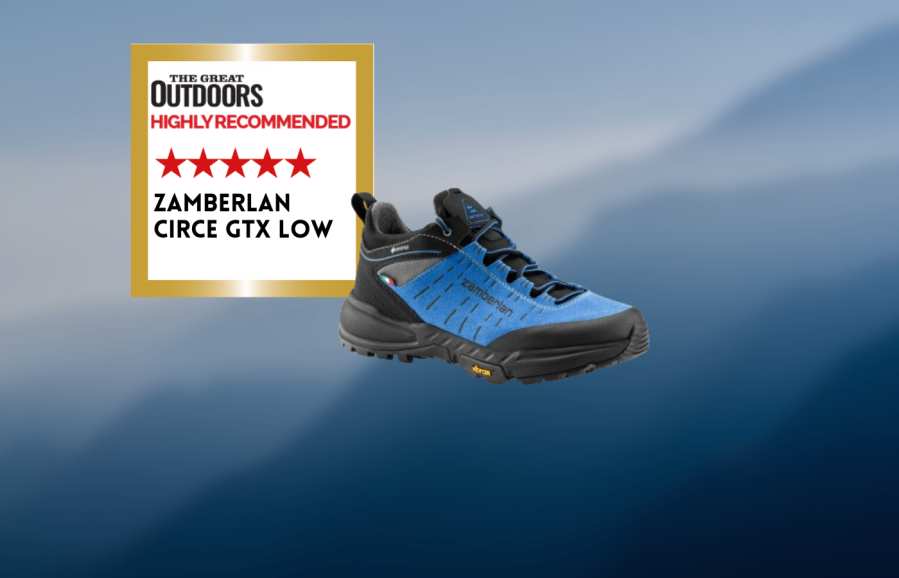
Lara Dunn’s Highly Recommended
They’re not cheap and they are quite weighty but these are a good looking, comfortable and effective alternative to boots for a lot of walks.- Supportive
- Cushioned
- Sturdy
- Weighty
- Expensive
| Quick specs | |
|---|---|
| Price: £210 Weight: 756g (for size 39) Materials: Microfibre upper, Gore-Tex lining, EVA midsole, Vibram Megagrip outsole Features: Asymmetric protective toe bumper, Gore-Tex lining, female specific design Sizes: UK4-UK9 / EU37-43 (including half sizes) Women’s/Men’s Version: Women’s (no men’s direct equivalent available) www.zamberlan.co.uk |
The Zamberlan Circe GTX Low is a sturdy, plush hiking shoe designed for lightweight summer ambles and stiff approach. It is built on a female-specific fit, providing ample cushioning for long hikes with a loaded pack. The shoe is available in half EU sizes, offering a wide range of sizes. The Vibram outsole is grippy and suitable for wet and dry surfaces, while the suede-effect microfibre upper with a Gore-Tex membrane is suitable for wet and muddy conditions. The protective asymmetric toe bumper is effective on rockier ground and can even be used for scrambling. Although not cheap and quite weighty, the Zamberlan Circe GTX Low is a good looking, comfortable, and effective alternative to boots for many walks.
See Lara Dunn’s full Zamberlan Circe GTX Low Review
Berghaus Ground Attack Active GTX
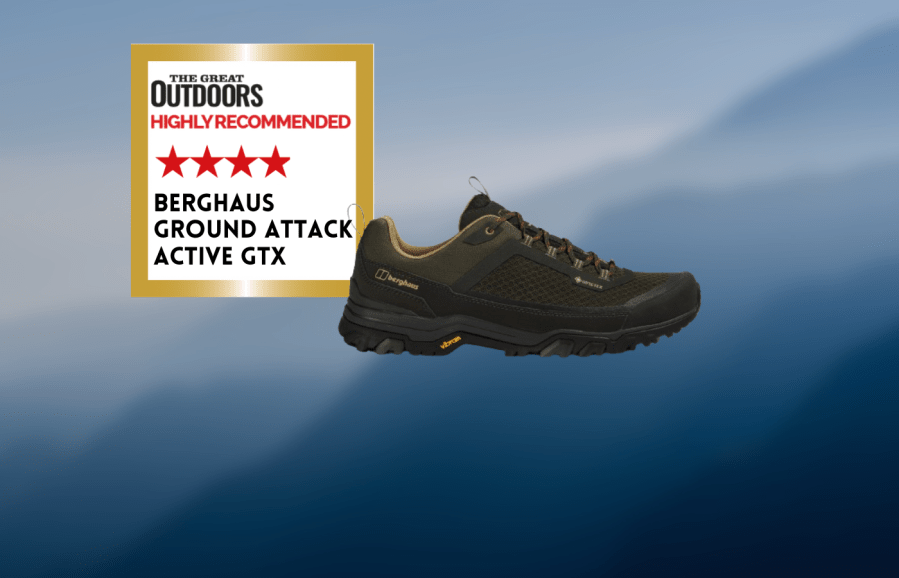
Alex Roddie Recommends
If you’re looking for lightweight shoes for general hillwalking, these will do the job well – and at a very decent price.- Soft & Comfy
- Good value
- Narrow forefoot for size
- Imprecise for scrambling
| Quick specs | |
|---|---|
| Price: £140 Weight: 460g (UK 11) Materials: 100% polyester (50% recycled) uppers Features: Opti-Stud Vibram outsole Waterproof: Gore-Tex Sizes: men: EU 40-45, UK 7-12; women: EU 36-40, UK 4-7.5 berghaus.com |
The Berghaus Ground Attack Active hiking shoes are lightweight, comfortable, and slipper-like, with a narrow fit across the forefoot. The uppers are made from lightweight 50% recycled polyester mesh, breathable, and have synthetic leather-like accents. The sole unit is durable, with widely spaced aggressive lugs, and they feel secure on various terrains. The shoes are suitable for general hillwalking on trails, but have a slightly slopy feel on rough off-path ground and scrambles. They are suitable for those looking for lightweight shoes for general hillwalking at a decent price.
Read Alex Roddie’s full Berghaus Ground Attack Active GTX Review
Salomon X Ultra 4 GTX
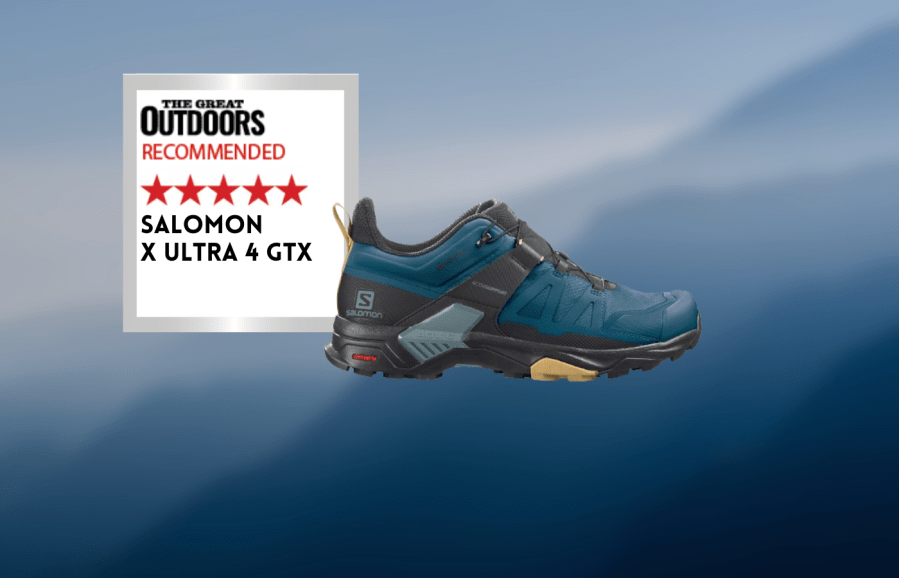
Lara Dunn Recommends
Where these really come into their own is that they’d look perfectly acceptable worn with jeans as well as hiking pants, making them good value for money as their day-to-day usefulness is enhanced- Casual look
- Versatile
- Good Value
- Quicklace system won’t suit everyone
| Quick specs | |
|---|---|
| Price: £155 Weight: 638g (for size 38.5) Materials: Textile and Gore-Tex upper, Salomon Contagrip outsole, Ortholite insole Features: Single pull Quicklace system, Gore-Tex lining, casual good looks Sizes: UK3.5-UK9.5 (including half sizes)/EU36-44 Women’s/Men’s Version: Women’s (men’s direct equivalent available) www.salomon.com |
The Salomon X Ultra 4 GTX hiking shoe is a trail running shoe with a unique design that combines trail running with hiking. The shoe features a Quicklace single-pull lacing system and fabric uppers, providing stability and protection for hikers. Built on a female-specific last, the shoe has a size range from UK3.5 to UK9.5, making it suitable for women with larger feet. The plush cushioning at the heel and ankle cuff prevents blisters. The outsole is aggressive but flexible, making it ideal for fast-paced hikers and those who prefer good feedback from the terrain. The shoe’s lightweight construction combines abrasion-resistant fabric uppers with toughened areas in high wear zones, using a Gore-Tex membrane to keep feet dry. The shoe’s low weight and fabric build make it less prone to overheating and non-sweaty feet. The shoe’s design makes it suitable for wearing with jeans and hiking pants, making it a good value for money.
Read Lara Dunn’s full Salomon X Ultra 4 GTX Review
Meindl Ontario Lady GTX
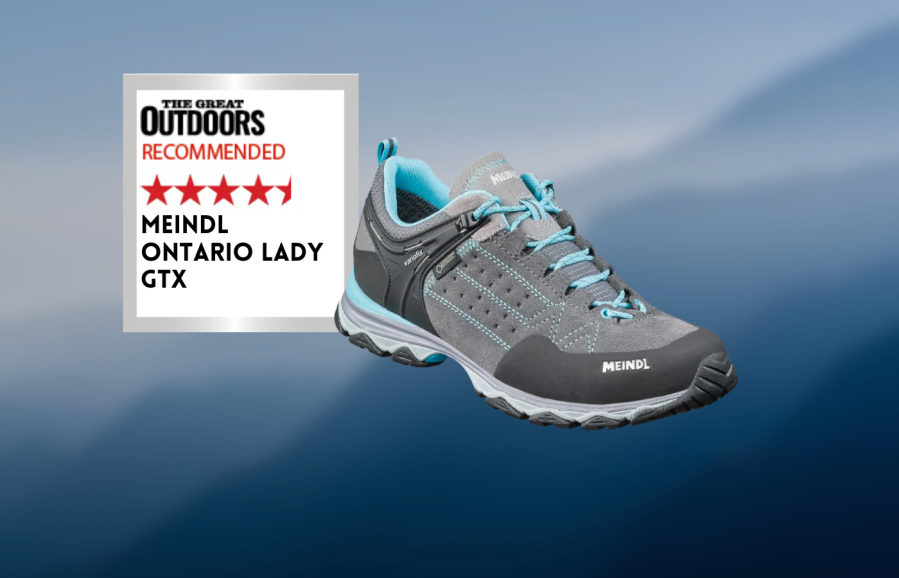
Lara Dunn Recommends
It’s a well-made, comfortable and practical shoe for a wide variety of uses, and it looks pretty good on and off the trail, so it’s easy to justify the price tag, given cost per wear.- Lightweight
- Supportive
- Versatile
- Relatively shallow outsole grip
| Quick specs | |
|---|---|
| Price: £179.99 Weight: 648g (for size UK6) Materials: Suede and mesh upper, Gore-Tex lining, Air-Active footbed, Meindl Magic Active sole Features: Variofix lacing system for superior hold around ankles Sizes: UK3.5-UK9 (including half sizes)/EU36-43 Women’s/Men’s Version: Women’s (men’s direct equivalent available) www.meindl.co.uk |
The Meindl Ontario Lady GTX hiking shoe is a low-key, blend of technical approach shoes and traditional hiking shoes, suitable for both trail and urban wear. It features a mix of suede and fabric mesh upper with a Gore-Tex lining for waterproofing and breathable comfort. The shoe offers good support and contours around the foot, with a Variofix lacing at the rear. The outsole is grippy on most surfaces but not as aggressive as some, making it best suited for drier conditions underfoot and well-defined trails. The shoe is well-made, comfortable, and practical for a wide variety of uses, making it easy to justify its price given the cost per wear. It is easy to care for and can withstand re-proofing treatments.
Read Lara Dunn’s full Meindl Ontario Lady GTX Review
How we test hiking shoes
Alex Roddie
Alex tested his hiking shoes on a series of day hikes and overnight backpacking trips in the Cairngorms and West Highlands. All weights are as measured on Alex’s digital scale (size UK 11).
Lara Dunn
Lara usually takes a size UK5.5/6 or EU38.5/39 depending on fit/shape/purpose of footwear. She does find that heel lift can often be a problem due to particularly narrow heels. These shoes were mostly tested on short and longer day walks in the Malvern Hills during an unusually wet autumn and winter, with additional forays to the Brecon Beacons and Black Mountains, with and without a rucksack.
How to choose a pair of hiking shoes
Hiking shoes actually come in a surprising amount of forms. There are out-and-out hiking shoes, approach shoes and then there are also trail running shoes. What’s the difference between trail shoes and hiking shoes? Which type of hiking shoes is best for you? That all depends on your preferences and needs. Let’s break down each category.
Hiking shoes
Imagine a hiking boot that has had the ankle cut off the top. That’s basically what an out-and-out hiking shoe is. It’ll have a grippy outsole, a slightly stiff but still slightly flexible sole, plenty of cushioning and usually a plate in the sole to block out things like protruding roots. Hiking shoes tend to have a tougher build than trail running shoes, with increased use of leather and durable nylons as opposed to mesh. The weight for a standard pair of hiking shoes will usually be around 1kg or just under 2 lb.
Approach shoes
An approach shoe is a versatile and hardy type of outdoor footwear that’s specifically designed to bridge the gap between hiking boots and climbing shoes. They’re usually made from materials like leather or synthetics and have grippy outsoles for traction on various surfaces. You’ll also often find them with a climbing zone on the sole for tackling mild climbing sections. With features like toe protection, cushioned midsoles, and a customizable lacing system, approach shoes offer a balance of comfort and support for both hiking and scrambling.
Generally, approach shoes will be comfortable for short to medium distance hikes but might be a little restrictive on long hikes – particularly multi-day stuff.
Trail running shoes
Hikers often opt for trail running shoes for several reasons. Firstly, trail running shoes offer a balance between lightweight comfort and durability, which is beneficial for covering long distances and varied terrain. Their design emphasizes agility and flexibility, allowing hikers to navigate uneven surfaces with ease. Additionally, the grippy outsoles of trail running shoes provide reliable traction on different trail conditions, enhancing stability and preventing slips. The breathable construction of these shoes helps keep feet cool during strenuous hikes and they’re often designed for fast drainage, so if your feet get wet, they won’t stay wet for long.
Waterproof of non-waterproof?
The choice between hiking shoes that are lined or unlined depends on a few things. First of all, I’d say that the climate and terrain that you’ll mainly be hiking in should dictate your choice. If you’re likely to be wearing the shoes in some wet conditions on a regular basis, you might want to opt for waterproof shoes. If you’ll mainly be hiking in hot and dry conditions, then your priority should be ventilation – and non waterproof shoes will suit you better in that case.
There’s another school of thought, however and that’s that non waterproof shoes are better, whatever the weather. Those who choose this approach would argue that hiking shoes are always going to let in some moisture when it rains (at the ankle), and it’s better to have shoes that can let that water out. These people will therefore favour hiking shoes that have good drainage and that can dry out quickly once the conditions improve.
For me, if I know I’m going to be hiking in wet weather for hours on end then I’ll favour the unlined, non waterproof approach. That’s because I’ve had long hikes where my waterproof shoes have basically turned into bath tubs for my feet and caused what could be diagnosed as trench foot! I’ll wear waterproof hiking shoes on days where I know there might be a bit of rain – but not too much – and I’ll want something to keep moisture from puddles and wet grass out. Then, of course, when it’s super hot and dry, I’ll always favour non-waterproof shoes just to keep my feet nice and ventilated.
Features to look for in hiking shoes
Comfort and fit
Although shoes tend to be more forgiving than boots, comfort is key in all footwear. Fit varies between brands, as different lasts are used. If you can, try footwear on before buying – and take your new shoes on a few easy walks before committing to a big hill day. A snug fit often feels more precise for scrambling. Look for the ability to adjust fit via the laces.
Cushioning
Most hiking shoes have more cushioning than lightweight running shoes, but may have less than boots. More cushioning generally results in more comfort but less precision on technical ground.
Stiffness and support
Although your own ankle strength is more important than a shoe’s ankle support, a stiffer midsole and a shoe offering more torsional support may feel more secure on rough, technical terrain – and may feel more forgiving if you’re used to traditional boots.
Durability
Hiking shoes are not as expensive as boots, but can be less durable. For better durability, look for thicker soles and uppers made from more durable materials, such as leather (natural or synthetic). Mesh uppers are less durable. A thick rubber rand can help protect the uppers.
Sole
Grip is just as important in hiking shoes as boots. Look for deep, well-spaced lugs. A positive edge to the sole will improve scrambling performance.
Waterproof?
Most hiking shoes have a waterproof/breathable liner. This helps keep feet try, but can also feel stuffy in hotter conditions, and on wet long-distance trails can actually result in wetter feet, as the shoes take longer to dry.
Environmental factors
Some shoes are partly made from recycled materials. However, few shoes can be resoled or completely recycled themselves. A shoe that lasts longer is a more environmentally friendly shoe.

